Lupinus adsurgens is a species of lupine known by the common name Drew's silky lupine. It is native to the Sierra Nevada and coastal mountain ranges of northern California and southern Oregon, where it grows in forest and other mountain habitat. It is a perennial herb growing 20–60 centimetres (7.9–23.6 in) in height. Each palmate leaf is made up of 6 to 9 leaflets each up to 5 centimetres (2.0 in) long. The herbage is hairy and silvery or gray-green in color. The inflorescence is up to 23 centimetres (9.1 in) long, bearing flowers just over a centimeter long. The flower is pale pink or purple to yellowish with a white or yellow patch on the banner. The fruit is a silky-haired legume pod 2 to 4 centimetres (1.6 in) long containing 3 to 6 seeds.
Lupinus affinis is a species of lupine known by the common name fleshy lupine. It is native to the California Coast Ranges from the San Francisco Bay Area north, and into southern Oregon, where it is an uncommon member of the flora in several areas. It is a hairy annual herb growing 20 to 50 centimetres in height. Each palmate leaf is made up of 5 to 8 leaflets each up to 5 centimetres long. The inflorescence is up to 20 centimetres (8 in) long, bearing whorls of flowers each about 1 centimetre long. The flower is purple-blue with a whitish patch on the banner. The fruit is a hairy legume pod up to 5 centimetres (2 in) long containing several seeds.
Lupinus antoninus is a rare species of lupine known by the common name Anthony Peak lupine. It is endemic to northern California, where it is known from only four occurrences in the North Coast Ranges, including near Anthony Peak.
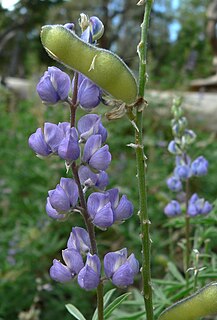
Lupinus argenteus is a species of lupine known by the common name silvery lupine. It is native to much of western North America from the southwestern Canadian provinces to the southwestern and midwestern United States, where it grows in several types of habitat, including sagebrush, grassland, and forests. This is a perennial herb growing erect to heights anywhere between 10 centimetres (3.9 in) and 1.5 metres (4.9 ft). It is sometimes silvery-hairy in texture and sometimes nearly hairless. Each palmate leaf is made up of 5 to 9 leaflets each up to 6 centimetres long. They are narrow and linear in shape, under a centimetre wide. The inflorescence bears many flowers, sometimes arranged in whorls. The flower is 5 millimetres (0.20 in) to 14 millimetres (0.55 in) long and purple, blue, or whitish in color. The banner, or upper petal, of the flower may have a patch of white or yellow. The fruit is a hairy legume pod up to 3 centimeters long containing several beanlike seeds. The plant is an important food source for butterflies. It also attracts birds and hummingbirds.
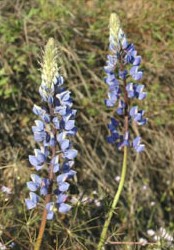
Lupinus benthamii is a species of lupine known by the common name spider lupine.
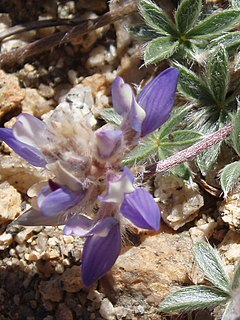
Lupinus breweri is a species of lupine known by the common names Brewer's lupine and matted lupine. It is native to much of California, except for the deserts, and to adjacent sections of Oregon and Nevada, where it is common in some areas, particularly mountain forests. Quite short for a lupine, this is a hairy, mat-forming perennial herb, sometimes becoming like a shrub, with a woody base. The leaves spread out from the stem. Each palmate leaf is made up of 5 to 10 woolly leaflets each up to 2 centimeters (0.79 in) long. The inflorescence is a dense raceme of flowers a few centimeters tall, each flower 4 to 11 millimeters. The flower is blue or purple with a white or yellowish spot on the banner. The fruit is a silky-hairy legume pod 1 or 2 millimeters long.
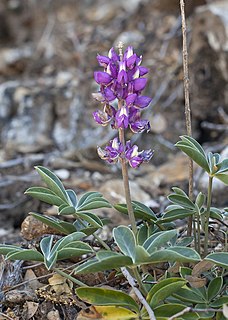
Lupinus cervinus is a species of lupine known by the common name Santa Lucia lupine. It is endemic to the Santa Lucia Mountains in the Central Coast Ranges in California, where it is an uncommon member of the flora in the mountain forests. This is a hairy gray-green perennial herb growing up to 30–70 centimetres (12–28 in) tall. The erect stem is surrounded by clusters of spreading leaves. Each palmate leaf is made up of 4 to 8 leaflets up to 8 centimetres (3.1 in) long and 3 centimetres (1.2 in) wide, which is wider than the leaflets of most lupines. The inflorescence bears many flowers, sometimes in whorls, each between 1 centimetre (0.39 in) and 2 centimetres (0.79 in) long. The flower is often bright pink, but may be shades of blue to nearly white. There is often a yellow patch on the banner. The fruit is a hairy legume pod up to 6 centimetres (2.4 in) long.
Lupinus constancei is a species of lupine known by the common name The Lassics lupine, or lassicus lupine. It is endemic to California, where it is known from only two occurrences in the Lassic Range in the North Coast Ranges. It is a member of the serpentine soils flora of the mountain forests. This is a low, mat-forming perennial herb no more than 15 centimeters high. Each small palmate leaf is made up of 6 or 7 leaflets up to 2 centimeters long and one wide. The herbage is coated in long, shaggy hairs. The inflorescence is a small, dense clump of several centimeter-long flowers. Each flower is pink in color with darker pink at the tip of the keel. The yellowish banner is reflexed. The fruit is a hairy legume pod 1.5 to 2.5 centimeters long.
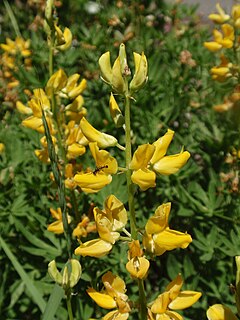
Lupinus croceus is a species of lupine known by the common name saffron-flowered lupine. It is endemic to the northernmost mountains of California, including the Klamath Mountains, where it grows in generally dry, rocky habitat. This is an erect perennial herb growing 40–60 centimetres (16–24 in) tall. The hairy palmate leaves are made up of 5 to 9 leaflets each up to 6 centimetres (2.4 in) long. The inflorescence is a raceme of many flowers, sometimes arranged in whorls. Each flower is just over a centimeter long and bright yellow to orange in color. The fruit is a hairy legume pod up to 3.5 centimetres (1.4 in) long.

Lupinus duranii is a species of lupine known by the common name Mono Lake lupine. It is endemic to California, where it is known mainly from the eastern slopes of the Sierra Nevada in western Mono County. Its distribution includes Mammoth Mountain and the hills around Mono Lake, and its habitat has gravelly, pumice-rich soils of volcanic origin.
Lupinus elmeri is an uncommon species of lupine known by the common names Elmer's lupine and South Fork Mountain lupine. It is endemic to California, where it is known only from a few scattered occurrences in the northernmost slopes of the North Coast Ranges. This is an erect perennial herb with a thick reddish stem and green, hairy herbage. It reaches a maximum height near 90 centimetres (35 in). Each palmate leaf is made up of 6 to 10 leaflets up to 6 centimetres (2.4 in) long. The inflorescence bears pale yellow flowers each roughly a centimeter long which are not arranged in whorls as they are in many other lupines. The fruit is a hairy legume pod up to 5 centimetres (2.0 in) long.

Lupinus flavoculatus is a species of lupine known by the common name yelloweyes, or yellow-eyed lupine.,
Lupinus grayi is a species of lupine known by the common name Sierra lupine. It is endemic to California, where its distribution extends the length of the Sierra Nevada and its foothills and includes the Tehachapi Mountains.

Lupinus hirsutissimus is a species of lupine known by the common names stinging annual lupine or stinging lupine. It is native to the coastal mountains of Baja California and Southern California as far north as the San Francisco Bay Area. It grows on dry mountain slopes, including areas that have recently burned, and chaparral and woodlands habitats.
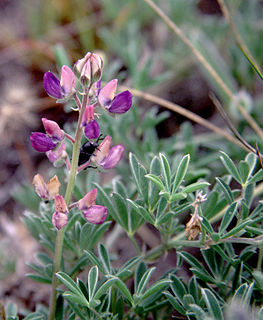
Lupinus littoralis is a species of lupine known by the common name seashore lupine. It is native to the coastline of western North America from British Columbia to northern California, where it grows in sandy habitat. It is a low perennial herb or subshrub growing in a clump or mat no more than 30 centimetres (12 in) tall. Each palmate leaf is divided into 5 to 9 leaflets up to 3.5 centimetres (1.4 in) long. The herbage is coated in long, shaggy whitish or silvery hairs. The inflorescence is raceme of whorled flowers each around a centimeter long. The flower is purple in color with a white patch on its banner that fades pinkish. The fruit is a hairy legume pod 3 or 4 centimeters long containing up to 12 seeds.
Lupinus luteolus is a species of lupine known by the common names pale yellow lupine and butter lupine. It is native to the coastal mountain ranges of Oregon and California as far south as the Transverse Ranges, where it grows in open habitat such as clearings and sometimes disturbed areas. It is an annual herb with a rigid stem growing to maximum heights anywhere between 30 centimeters and 1.5 meters, and known to exceed that at times. Each palmate leaf is made up of 7 to 9 hairy leaflets 1 to 3 centimeters long. The inflorescence is a raceme of crowded whorls of flowers each just over a centimeter long. The flower is often pale to bright yellow, but can be blue or pinkish. The fruit is a hairy, rounded or oval legume pod generally containing 2 seeds.
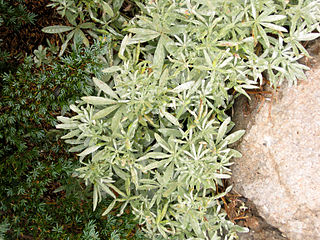
Lupinus obtusilobus is a species of lupine known by the common name bluntlobe lupine. It is native to high mountains of northern California, including the North Coast Ranges, the Klamath Mountains, and the northernmost Sierra Nevada. It grows in various types of mountain habitat, sometimes carpeting meadows with its purple blooms in the spring. It is a perennial herb growing erect or decumbent along the ground, its stem 15–30 centimetres (5.9–11.8 in) long. Each palmate leaf is made up of 6 to 7 leaflets up to 5 centimetres (2.0 in) long. The herbage is coated in silvery silky hairs. The inflorescence is a small raceme with a few whorls of flowers each just over a centimeter long. The flower is blue to purple with a yellowish patch on its banner. The fruit is a silky-haired legume pod up to 4 centimetres (1.6 in) long.
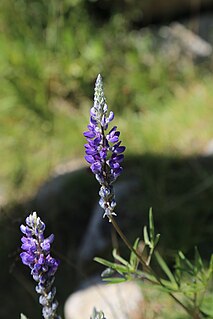
Lupinus pratensis is a species of lupine known by the common name Inyo meadow lupine. It is endemic to California, where it grows in the central Sierra Nevada and adjacent plateau and valleys to the east. It grows in relatively moist habitat, such as streambanks and spring meadows. This is an erect perennial herb growing 30–70 centimetres (12–28 in) tall. Each palmate leaf is made up of 5 to 10 narrow leaflets sometimes exceeding 10 centimetres (3.9 in) long. The leaves are borne on long petioles which can reach 25 centimetres (9.8 in) in length. The herbage is green and coated in thin hairs. The inflorescence is a dense raceme of many flowers each around a centimeter long. The flower is dark blue or purple with a reddish or orange patch on its banner. The fruit is a hairy legume pod around 2 centimetres (0.79 in) long.

Lupinus sericatus is a species of lupine known by the common name Cobb Mountain lupine. It is endemic to the North Coast Ranges of California north of the San Francisco Bay Area, where it grows in the forest, woodlands, and chaparral of the slopes and canyons. It easily colonizes disturbed habitat as well. This is a perennial herb growing up to half a meter tall. Each palmate leaf is made up of 4 to 7 distinctive wide spoon-shaped leaflets each 3 to 5 centimeters long. The inflorescence is a raceme of several whorls of purple flowers, each flower between 1 and 2 centimeters long. The fruit is a hairy legume pod 2 or 3 centimeters long.

Lupinus truncatus is a species of lupine known by the common name collared annual lupine.













